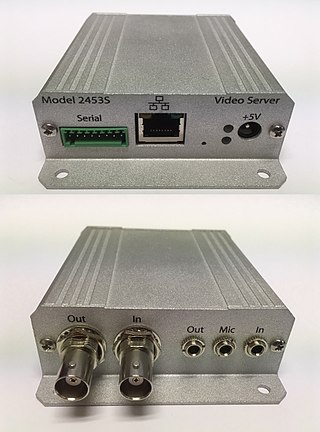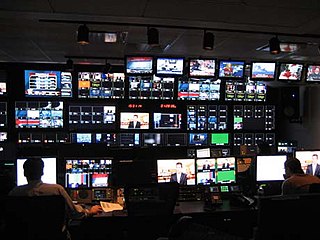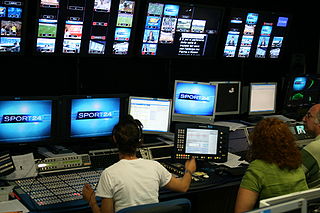
Digital television (DTV) is the transmission of television signals using digital encoding, in contrast to the earlier analog television technology which used analog signals. At the time of its development it was considered an innovative advancement and represented the first significant evolution in television technology since color television in the 1950s. Modern digital television is transmitted in high-definition television (HDTV) with greater resolution than analog TV. It typically uses a widescreen aspect ratio in contrast to the narrower format of analog TV. It makes more economical use of scarce radio spectrum space; it can transmit up to seven channels in the same bandwidth as a single analog channel, and provides many new features that analog television cannot. A transition from analog to digital broadcasting began around 2000. Different digital television broadcasting standards have been adopted in different parts of the world; below are the more widely used standards:

The first American standard for analog television broadcast was developed by National Television System Committee (NTSC) in 1941. In 1961, it was assigned the designation System M.
Genlock is a common technique where the video output of one source is used to synchronize other picture sources together. The aim in video applications is to ensure the coincidence of signals in time at a combining or switching point. When video instruments are synchronized in this way, they are said to be generator-locked, or genlocked.

Advanced Television Systems Committee (ATSC) standards are an American set of standards for digital television transmission over terrestrial, cable and satellite networks. It is largely a replacement for the analog NTSC standard and, like that standard, is used mostly in the United States, Mexico, Canada, and South Korea. Several former NTSC users, such as Japan, have not used ATSC during their digital television transition, because they adopted other systems such as ISDB developed by Japan, and DVB developed in Europe, for example.
This is an index of articles relating to electronics and electricity or natural electricity and things that run on electricity and things that use or conduct electricity.
Broadcasttelevision systems are the encoding or formatting systems for the transmission and reception of terrestrial television signals.
HD-MAC was a broadcast television standard proposed by the European Commission in 1986, as part of Eureka 95 project. It belongs to the MAC - Multiplexed Analogue Components standard family. It is an early attempt by the EEC to provide High-definition television (HDTV) in Europe. It is a complex mix of analogue signal, multiplexed with digital sound, and assistance data for decoding (DATV). The video signal was encoded with a modified D2-MAC encoder.
Broadcast automation incorporates the use of broadcast programming technology to automate broadcasting operations. Used either at a broadcast network, radio station or a television station, it can run a facility in the absence of a human operator. They can also run in a live assist mode when there are on-air personnel present at the master control, television studio or control room.

A video server is a computer-based device that is dedicated to delivering video. Video servers are used in a number of applications, and often have additional functions and capabilities that address the needs of particular applications. For example, video servers used in security, surveillance and inspection applications typically are designed to capture video from one or more cameras and deliver the video via a computer network. In video production and broadcast applications, a video server may have the ability to record and play recorded video, and to deliver many video streams simultaneously.

Master control is the technical hub of a broadcast operation common among most over-the-air television stations and television networks. It is distinct from a production control room (PCR) in television studios where the activities such as switching from camera to camera are coordinated. A transmission control room (TCR) is usually smaller in size and is a scaled down version of centralcasting.

A vision mixer is a device used to select between several different live video sources and, in some cases, compositing live video sources together to create visual effects.

A television studio, also called a television production studio, is an installation room in which video productions take place, either for the production of live television and its recording onto video tape or other media such as SSDs, or for the acquisition of raw footage for post-production. The design of a studio is similar to, and derived from, movie studios, with a few amendments for the special requirements of television production. A professional television studio generally has several rooms, which are kept separate for noise and practicality reasons. These rooms are connected via 'talkback' or an intercom, and personnel will be divided among these workplaces.

The production control room (PCR) or studio control room (SCR) is the place in a television studio in which the composition of the outgoing program takes place.
The Technology and Engineering Emmy Awards, or Technology and Engineering Emmys, are one of two sets of Emmy Awards that are presented for outstanding achievement in engineering development in the television industry. The Technology and Engineering Emmy Awards are presented by the National Academy of Television Arts and Sciences (NATAS), while the separate Primetime Engineering Emmy Awards are given by its sister organization the Academy of Television Arts & Sciences (ATAS).
Time base correction (TBC) is a technique to reduce or eliminate errors caused by mechanical instability present in analog recordings on mechanical media.
In broadcasting, channel playout is the generation of the source signal of a radio or television channel produced by a broadcaster, coupled with the transmission of this signal for primary distribution or direct-to-audience distribution via any network. Such radio or television distribution networks include terrestrial broadcasting, cable networks, satellites, IPTV, OTT Video, point-to-point transport over managed networks or the public Internet, etc.

A transmission control room (TCR), transmission suite, Tx room, or presentation suite is a room at broadcast facilities and television stations around the world. Compared to a master control room, it is usually smaller in size and is a scaled-down version of centralcasting. A TX room or presentation suite will be staffed 24/7 by presentation coordinators and tape operators and will be fitted out with video play-out systems often using server based broadcast automation.
A color suite is the control room for color grading video in a post-production environment.

A television production truck or OB van is a small mobile production control room to allow filming of events and video production at locations outside a regular television studio. They are used for remote broadcasts, outside broadcasting (OB), and electronic field production (EFP). Some require a crew of as many as 30 people, with additional trucks for additional equipment as well as a satellite truck, which transmits video back to the studio by sending it up through a communications satellite using a satellite dish, which then transmits it back down to the studio. Alternatively, some production trucks include a satellite transmitter and satellite dish for this purpose in a single truck body to save space, time and cost.
Channel in a box is the name given to an all-in-one playout device for broadcast television. Commonly based on a standard PC, it includes the ability to store content immediately required, add graphics, and deliver it to a transmission chain. Thus it provides an integrated, software playout platform.











